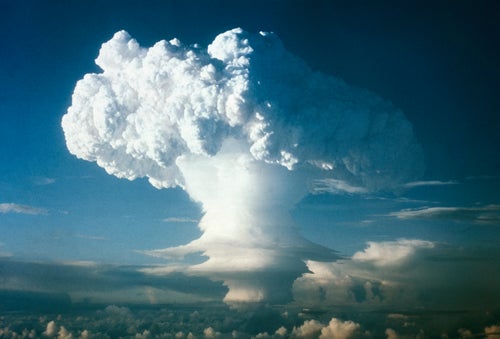



The world is going to end, unfortunately. It’s inevitable. According to the Doomsday Clock, we’re 2.5 minutes away from midnight. Only once have we been closer to global catastrophe, and up until last year we were a respectable three minutes away.
Although a number of things contributed to the clock’s 30 second change, the threat of nuclear war certainly played a role this time. Hardly a week goes by without mention of nuclear weapons and the potential for all-out destruction of civilisation. Only last week, Hawaiians were issued a warning over a ballistic missile threat, which fortunately turned out to be a false alarm. A terrifying notice, no doubt, but it’s not even the first time this has happened; since 1945 there have been three false alarms worldwide, the most recent one being in 1995.
I listened to a podcast recently in which one of the interviewees said that “every generation assumes that the world will end in their lifetime”, and I completely agree. It has been suggested that this is because each generation wants to believe they are special; they don’t like to acknowledge that life will go on after they’re gone. While I can see some truth behind this theory, it’s also hard not to be terrified of all the things that could wipe us out because there are so many... and they’re only increasing.
But you know what? It’s actually quite comforting to understand the threats we face. That’s why this week HuffPost UK will be taking a deeper look at some of the threats to human existence, why they might happen, and how we can survive afterward. From supervolcanoes to asteroids to solar flares, we’ll have experts guiding you through what would happen if disaster strikes. We’ll look at where you should go if a virus wipes out your city, what natural foods are best to eat if you’ve run out and you’ve witnessed the ultimate Supermarket Sweep, and why a golf cart could be your best asset when civilisation comes to an end.
Like our dinosaur friends we could be taken out by an asteroid, or lethal autonomous weapons (literal killer robots) may see us off, or there may come a time when insects disappear (when was the last time a bug flew into your windscreen?), which would give the human race just over a few months, as according to one of our experts, “they are the ecological glue without which our natural systems cannot function”.
And did you know that, since 2008, 26.4 million people have been displaced due to natural hazards? It’s not surprising when you look at all the natural disasters that have occurred even just this year. Or that experts predict that by 2050 antibiotic-resistance will kill 10million people a year? Through this series we will also explore the potential consequences of the lack of respect with which we treat our planet, its resources and its wildlife, so we can better understand how to fix it.
We can’t rely on the hope that there will be another planet that humans can jump onto, although one of our experts will be looking into the possibility of life on planets outside our solar system. For now, we’re stuck with the one we’ve got, so let’s make the most of it.
HuffPost UK Tech has launched HuffPost-Apocalypse, a project that aims to investigate what an apocalypse would mean for humanity, how we can best delay the end of the world, what the world will look like after we’re gone and what the best viable options for survival will be for anyone left. Join in the conversation with #HuffPostApocalypse on Twitter. To read more from the series, visit our dedicated page.